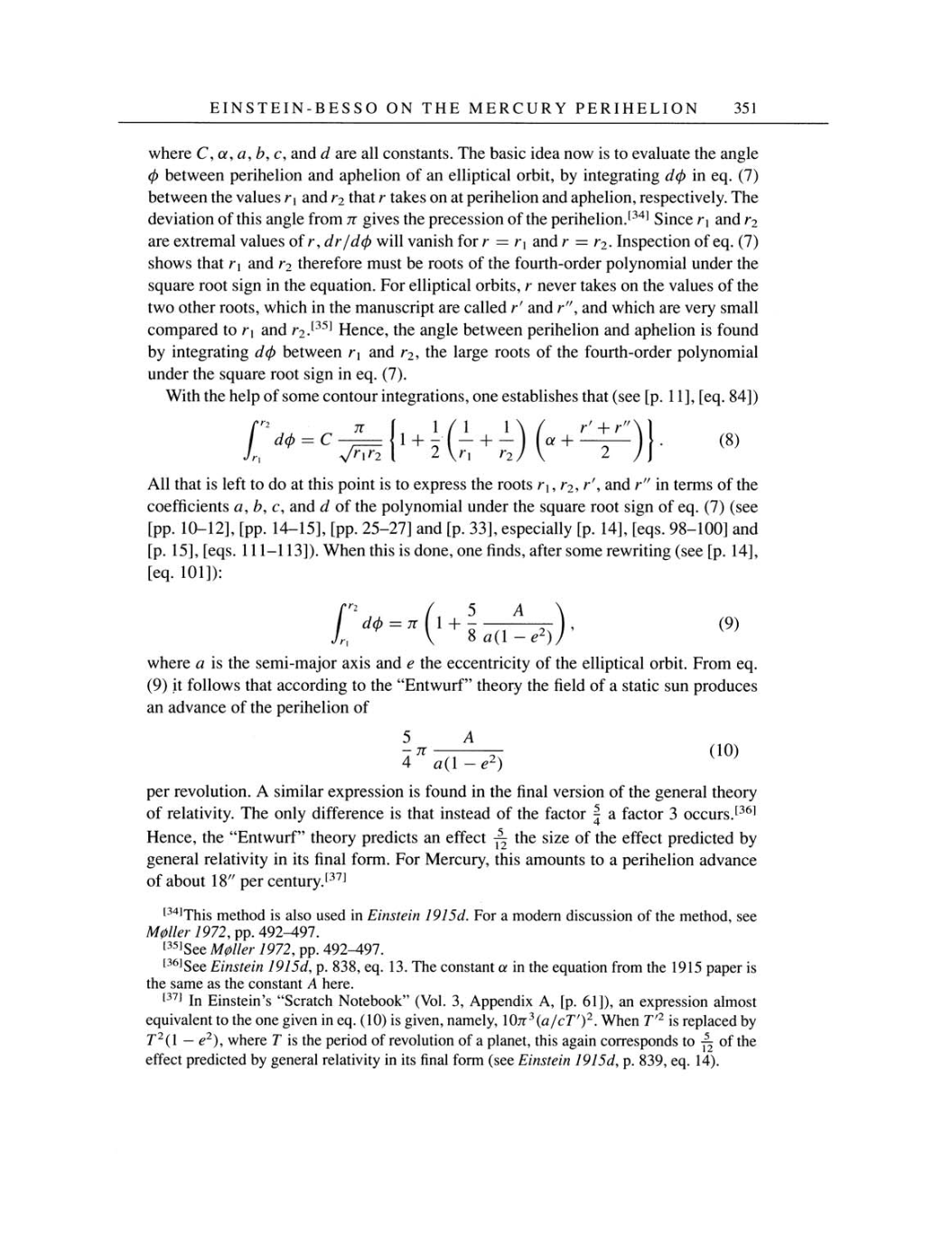EINSTEIN-BESSO ON THE
MERCURY
PERIHELION
351
where
C,
a, a, b, c,
and d
are
all constants.
The basic idea
now
is to
evaluate
the
angle
0 between
perihelion
and
aphelion
of
an
elliptical orbit,
by
integrating
dcp
in
eq.
(7)
between the values
r1
and
r2
that
r
takes
on
at
perihelion
and
aphelion, respectively.
The
deviation of
this
angle
from
it
gives
the
precession
of
the
perihelion.[34]
Since
r1
and
r2
are
extremal values of
r,
dr/dcj)
will vanish for
r
= r1
and
r
=
r2. Inspection
of
eq.
(7)
shows that
r1
and
r2
therefore
must be roots
of the fourth-order
polynomial
under the
square
root
sign
in
the
equation.
For
elliptical
orbits,
r never
takes
on
the
values of
the
two
other
roots,
which
in
the
manuscript
are
called r'
and r", and
which
are very
small
compared
to
r1
and
r2.[35]
Hence,
the
angle
between
perihelion
and
aphelion
is
found
by
integrating
dcj)
between
r1
and
r2,
the
large
roots
of the fourth-order
polynomial
under the
square
root
sign
in
eq. (7).
With the
help
of
some
contour
integrations,
one
establishes that
(see [p. 11],
[eq.
84])
f
do=C
-{1+2(+)(a+r+r)} (8)
All
that
is
left
to do at
this
point
is to
express
the
roots
r1, r2,
r',
and
r"
in terms
of
the
coefficients
a, b, c,
and
d
of the
polynomial
under the
square
root
sign
of
eq. (7) (see
[pp.
10-12],
[pp.
14-15],
[pp.
25-27]
and
[p.
33], especially
[p.
14],
[eqs.
98-100] and
[p.
15],
[eqs.
111-113]).
When
this is done,
one
finds,
after
some
rewriting (see
[p.
14],
[eq.
101]):
f
do=u(1+5A),
(9)
where
a
is
the
semi-major
axis and
e
the
eccentricity
of
the
elliptical
orbit.
From
eq.
(9)
it
follows that
according
to
the "Entwurf"
theory
the
field
of
a
static
sun
produces
an
advance of
the
perihelion
of
5 A
4 a(
1
-
e2)
(10)
per
revolution.
A
similar
expression
is
found
in
the
final
version of the
general theory
of
relativity.
The
only
difference
is
that instead of the factor
|
a
factor
3
occurs.[36]
Hence,
the "Entwurf"
theory predicts
an
effect
5
the size
of the effect
predicted
by
general
relativity
in its final
form. For
Mercury,
this amounts to
a
perihelion
advance
of about
18"
per
century.[37]
[34]This
method
is
also used
in
Einstein 1915d. For
a
modern discussion of
the
method,
see
Moller 1972,
pp.
492-497.
[35]See Moller 1972,
pp.
492-497.
[36]See
Einstein
1915d,
p.
838,
eq.
13.
The
constant
a
in
the
equation
from the
1915
paper
is
the
same
as
the
constant
A
here.
[37]In Einstein's "Scratch Notebook"
(Vol.
3, Appendix
A, [p.
61]),
an expression
almost
equivalent to
the
one
given
in
eq. (10)
is
given, namely,
\0n3(a/cT')2. When
T'2 is
replaced
by
T2(1
-
e2),
where
T is
the
period
of revolution of
a planet,
this
again
corresponds
to
of
the
effect
predicted
by
general relativity
in its final
form
(see
Einstein
1915d,
p.
839,
eq. 14).
